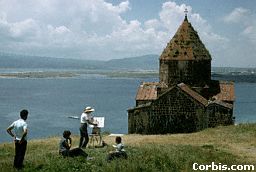| Group | Single |
| Geography | Nowadays it is spoken by the Armenian people in Turkey and the Republic of Armenia, and in Armenian settlements elsewhere in the Middle East, Europe and the United States. |
| History | Armenian is known to have replaced the earlier languages of the historical Armenian region by at least the 7th century B.C., and it may have been influenced by the languages it replaced. In 410 A.D., according to tradition, Armenian acquired an alphabet invented by St. Mesrob, a monk and scholar. A literature appeared by the 5th century, and the written language of that era, called Grabar or Classical Armenian, while incorporating various changes remained the literary language until the 19th century. Meanwhile, the spoken language developed independently; many dialects appeared, not all mutually intelligible. A nationalist movement in the 19th century led to the creation of two slightly different modern literary dialects which are closer to the spoken language: Eastern or Yerevan Armenian (the official language of the Armenian republic) and Western or Turkish Armenian. The differences in the two dialects are simple. The Armenian alphabet has 2 r-s, 3 ch-s, 3 t-s and 2 p-s. In Western Armenian, some of the distinctions between the relatively soft d and the middle t have disappeared, for instance, whereas in Eastern Armenian the sounds are distinct. A Western Armenian speaker can hear the differences, but not using them, they have melted away and are assigned as odd-looking spellings using two different t-s in the same word. The other difference is the conjugation of verbs. The present tense in Western Armenian looks like the future tense in Eastern Armenian. The marker for the future tense in Western Armenian elicits strange looks from Eastern Armenian speakers. The present tense in Eastern Armenian has the same root word, but is formed differently. |
| Phonetics | Already in Grabar the opposition between long and short vowels disappeared, several new affricates emerged borrowed from aboriginal languages of the Caucasus. Syllabic sonants were turned into vowels. The reflection of stops was similar to the Germanic "shift": three series of voiced, voiceless and voiceless aspirated exist in Armenian. |
| Nominal Morphology | Several Indo-European noun inflections are still seen in Classical Armenian, the modern system of declension is more agglutinative. The system of pronouns is also Indo-European-type. Today Armenian nouns have no gender, the plural number is formed by agglutinative suffixes, there are up to 7 cases and 8 main types of declension. |
| Verbal Morphology | The structure of the verb is quite complicated, using 3 voices (active, medium, passive), 3 persons, 2 numbers, 5 moods (indicative, imperative, optative, conditional, causative) and three tenses (present, past, future). Practically all these forms are analytical. |
| Lexicon | Includes numerous Iranian, Turkish and Caucasian words, though the most ancient vocabulary remains Indo-European. |
| Writing | Armenian alphabet |
| Close Contacts | Because of the presence of many words borrowed in ancient times from the Iranian languages Armenian was long believed to be an Iranian dialect. Modern scholarship has firmly established it as an independent branch of the Indo-European language family and in more recent times has added Phrygian to this group. |
| Sample | .
. |
| Picture |  |
| More info |